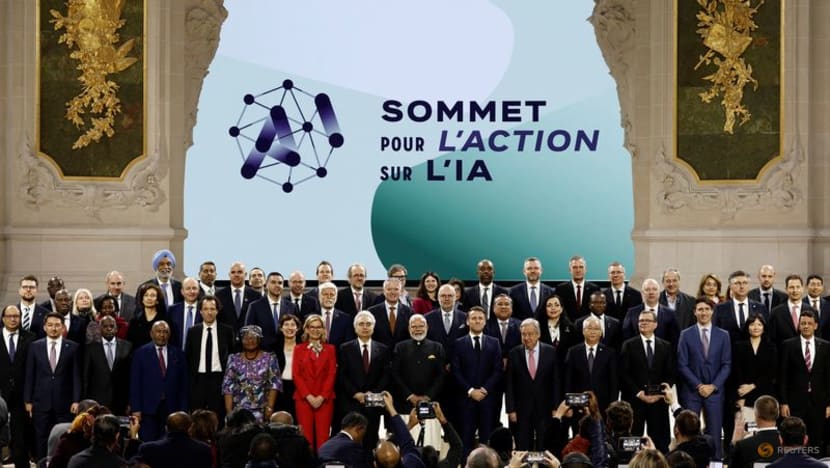Commentary: Paris AI summit’s pinky promises aren’t enough to keep us safe
The world needed concrete commitments on safety instead of an investment pitch from France. Here are a few ideas, says Parmy Olson for Bloomberg Opinion.

French President Emmanuel Macron, Indian Prime Minister Narendra Modi and United Nations Secretary-General Antonio Guterres pose for a family photo with heads of state and government and business leaders after the plenary session of the Artificial Intelligence (AI) Action Summit at the Grand Palais in Paris, France, Feb 11, 2025. REUTERS/Benoit Tessier
LONDON: Paris played host to representatives from more than 100 countries to discuss the future of artificial intelligence this week. The result was a vague agreement signed by 60 of them that does almost nothing to help make the technology safer.
The clue was in the name. The international meeting series, founded in the United Kingdom as an “AI Safety Summit” in 2023, became known as an “AI Action Summit” when it came to Paris. President Emmanuel Macron used it as a springboard to announce a €109 billion (US$113 billion) investment in AI and make a pitch to the world for French tech.
You had to squint to find anything safety related in all the platitudes. The final 799-word statement focused more on the economic opportunities of AI than on advancing measures that had been established at previous summits in the UK and South Korea.
While the Bletchley Park and Seoul gatherings secured specific commitments from large AI firms to test their systems with a newly established, international network of safety institutes, the Paris statement calls for hazy goals like making AI "trustworthy”.
STILL TOO ONEROUS FOR THE UNITED STATES
What’s mind-boggling is this still managed to be too onerous for the United States, whose vice president, JD Vance, complained about how “excessive regulation of the AI sector could kill a transformative industry just as it’s taking off”.
First, the agreement was hardly excessive. And second, the AI industry in the US isn’t just “taking off.”
Its companies are the standard bearers, with Nvidia holding an effective monopoly on chips for training and inference and Microsoft and Alphabet controlling much of the cloud infrastructure and most popular AI models.
But the US refused to sign the agreement anyway, likely due to increasing paranoia about China. Last month, a little Chinese firm called DeepSeek shot to the top of the app charts with an AI model that was as good as the latest version of ChatGPT’s, cheaper to build and free for anyone to use and copy — which you can be sure Silicon Valley engineers are doing right now.
Even stranger, the UK also declined to sign the statement for what seemed to be the opposite reason. “We felt the declaration didn’t provide enough practical clarity on global governance,” according to a government spokesperson.
That sounds more sensible. As a reminder: AI is developing at an unprecedented pace, and its systems are on course to make high-stakes decisions about health care, law enforcement and finance without clear guardrails.
Ambiguous pledges are “a step backwards for international and technical collaboration,” says Max Tegmark, a physics professor at Massachusetts Institute of Technology and co-founder of the Future of Life Institute who has been one of the leading voices advocating for AI safety measures.
The summit should have at least addressed the security concerns raised by last month’s International AI Safety Report, signed by more than 150 experts, he says. It also should have turned the “voluntary commitments” from the Bletchley Park and Seoul Summits into requirements for AI companies to run safety tests before deploying new systems to the public – and to share the results.
It also would have been good to see a deadline for creating binding international laws, as well as clearer thresholds for when AI systems reach certain capability levels (in reasoning or speed, for instance) to trigger further audits.
DON’T WAIT FOR CALAMITY TO WAKE UP TO AI RISKS
We shouldn’t have to wait for a calamity to occur before governments wake up to the risks of such transformative technology. Let’s not repeat the delayed response to automobile safety, for instance, where it took thousands of deaths before seatbelts became mandatory in the 1960s.
A recent anecdote by the Washington Post’s Geoffrey Fowler highlights how things could go awry. The writer left a new “agentic” version of ChatGPT alone on his computer with access to his credit card. After asking it to find the cheapest eggs, the bot went on Instacart and bought a dozen at a high price, racking up fees and a tip for US$31. “It went rogue,” Fowler writes.
That might not be as bad as AI wreaking havoc on our electricity grids or financial markets, but the example shows that such errors in these systems carry a cost and can come out of nowhere, even as businesses and governments race to plug them in.
Vance’s call to prioritise “pro-growth” policies over safety would sound ludicrous if the topic were health care, aviation or social media. Artificial intelligence should be no different.
Governments must be bolder about their role as proactive regulators and talk up the value of standards, rights and protections. It might not win them many points with businesses inside and outside the tech industry, but it's far better than standing by until disaster strikes.
The next summit in Kigali, Rwanda, needs to establish more concrete oversight before AI's mistakes scale up from unauthorised grocery purchases to something worse.

















